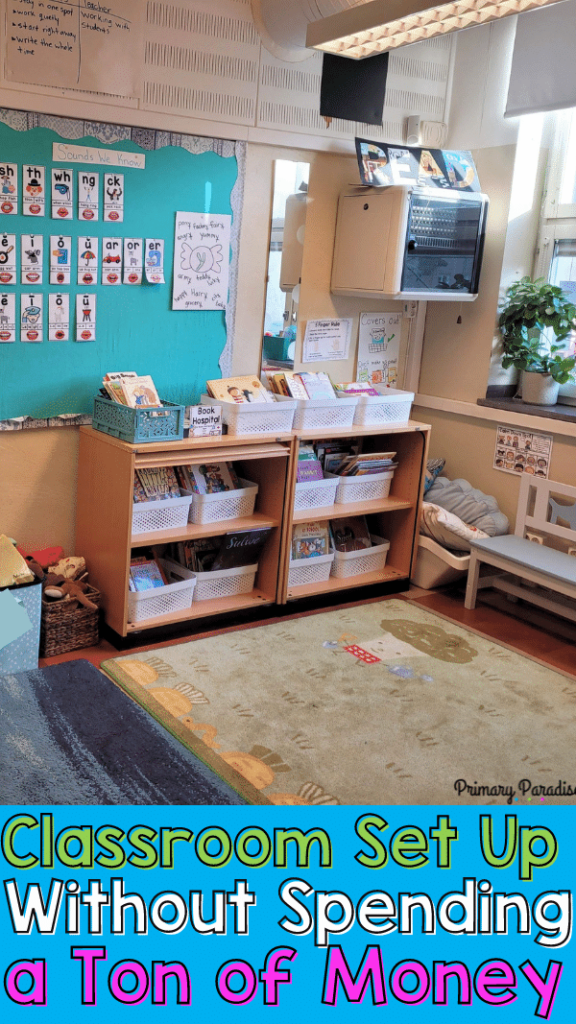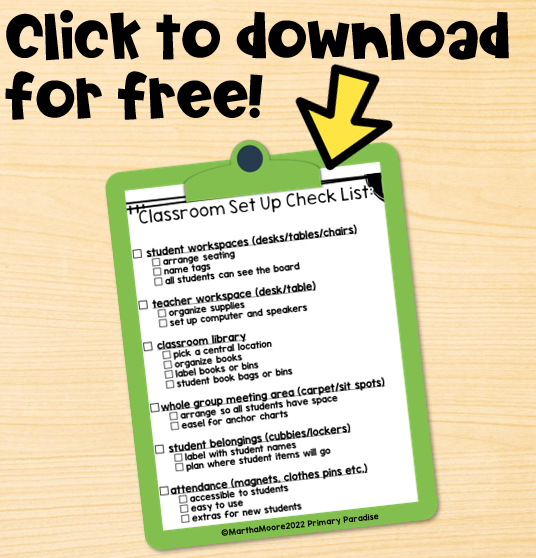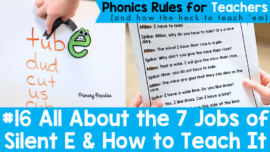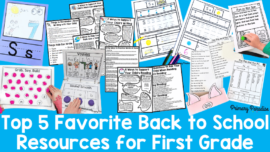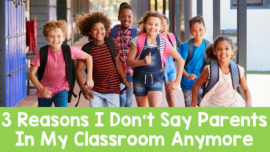Classroom set up is important because how well your classroom works for you and your students will impact your year. However, if you take a look at Instagram, you might begin to feel overwhelmed. New teachers might feel like they need to pour hundreds of thousands of dollars into their classroom. This is just not realistic or true. Here is how to set up an elementary classroom without spending a ton of money.
What You Don’t Need to Do When You Set Up a Classroom
First, let’s talk about what you don’t need to do when you’re setting up your classroom. Of course, if you want to do some of these things, that’s okay. But, none of the following are requirements for setting up a classroom. In fact, none of these this will impact student learning. Since our job is to teach, our main focus when we’re doing things like selecting activities and resource or setting up our classroom is to ask ourselves this: “What will work best to promote student learning and well-being?”
Things You DON’T Need To Do
- You don’t need to compare with what you see online. We’re going to start with this one because it’s the most important in my opinion. It’s easy to see perfect-looking brightly colored classrooms where everything matches and feel inadequate. But, here’s the thing. Many of those classrooms are fake. As in, literally there are people who stage a corner of a their classroom, or a room of their house even, to take a picture to sell you their classroom decor. Sometimes these teacher are no longer in the classroom, so what you’re seeing isn’t actually a classroom where students are learning. I am not knocking this (well, maybe a little but it’s not about the selling… we’ll get to what I have a problem with a little further down), but it’s important to be aware. The point is, so much of the classrooms we see online are curated and cropped and staged. So, it’s important to keep that in mind. Most classrooms don’t look perfect all the time, even if it appears that way online.
- You don’t need a theme. Contrary to popular belief, there is no requirement to have a themed classroom. In fact, having the theme of “we learn here” is a great goal. I did have a themed classroom early on in my teaching career, and I wouldn’t do it again. However, this was before Pinterest and Instagram (I am basically a dinosaur), so it wasn’t quite so over the top. Of course, there is nothing wrong with having a theme. The problem is if you’re spending a ton of money to get everything in a particular theme or color to match. That can get very expensive. Additionally, trends change, so you might feel pressure to change your theme yearly. Again, this would get very expensive and then you’re left with what to do with the stuff you no longer what to use. A good theme to focus on would be, again, “we learn here”.
- You don’t need everything to match. Along the same lines, it is not a requirement for everything to match. Trying to make everything in your classroom match can also be very expensive. There’s nothing wrong with having things compliment each other or go together, but it’s definitely not a requirement to have a classroom where students are learning.
- You don’t need every space to be covered with “cute” decor and posters. One of the big reasons I take issue with the “perfect” online classrooms is that they’re far from the perfect learning environment. Often times this classrooms are way too visually stimulating and overwhelming. There are too many patterns and colors that would end up being a distraction for actual students. Posters with cute sayings and silly puns are popular as well. However, I would encourage you to think very carefully before putting up any posters. (Posters are stagnant and more for decoration than learning which is different from anchor charts which are valuable learning tools.) Again, (are you noticing a theme?) instead of cute and puny, we should focus on “here is a great space for learning.” That often means using the wall real estate with intention.
- You don’t need to spend a ton of money. When I first started teaching, I just assumed I would have to spend a lot of money to get my classroom functional. This is a huge problem, and I don’t think much has changed in the last 12 years. In fact, with the rise of Pinterest and teacher influencers, I think it’s gotten worse. There is a difficult internal battle where we know, as teachers, that the government funded classroom we will walk into isn’t going to be everything we need. However, we also have to realize that it shouldn’t be the teacher’s responsibility to spend their own money to fill that gap. So, while I’d love to say just use what you are provided, I realize that in many cases, that means a classroom with desks, chairs, and maybe a box of expo markers if you’re lucky. Of course, you could make that work, but I also fully understand that most teachers want more and better for their students. So, while we should continue to fight for fully funded, functional, inclusive classroom spaces, in the meantime we can choose if and how we spend any money very carefully. You should not go in debt to furnish your workspace. And, that is in fact what your classroom is. So, let’s five into what you do need when you set up your classroom with this in mind.
What You Do Need to Do When You Set Up a Classroom
- Focus on student learning. First and foremost, when you’re setting up your classroom, you need to focus on student learning. As you’re planning out your room and dragging tables from one side of the space to the other, ask yourself, “What will make it easiest for my students to learn?” This isn’t only an abstract idea. An environment that isn’t distracting, access to the resources they will use, and a logic order and organization that is designed for students will help students learn. However you decide to organize your classroom, student learning needs to be at the forefront of your thoughts.
- Keep your space as calm and muted as possible. Students spend a lot of time in their classrooms. You will have a variety of students with a variety of needs. One big thing to keep in mind is that things adults will find cute might be very distracting for students. It might be tempting to put up a ton of cute posters and decor, but that can be very overwhelming when students are trying to focus. Kids are easily distracted enough, they any help in that area. When planning out out your space, put things up with a purpose. If it’s just cute for cute sake, just skip it. Focus on items with a purpose. (Well go more into specific things to have in your classroom below.)
- Use what you have available. Often if you’re moving into a classroom, the previous teacher will have left some things behind. Additionally, at the beginning of the year, other teachers are often clearing out and giving away things they no longer need. You can use those items in your own classroom. Two free mismatched bookshelves are better than two costly new ones if you’re footing the bill. If you have family who are getting rid of things, you can also take those items as well. Some of my favorite classroom items in my current classroom came with the room and I made them work for my needs. I’ve also found retiring teachers are normally happy to pass on their supplies, decor, and furniture.
- Before you spend your own money, ask about a budget or reimbursement. Although most school districts are tremendously underfunded, that doesn’t mean there’s no budget for classroom needs. When you get a job in a new school or district, ask if you have a classroom spending budget or if you’re able to be reimbursed for certain purchases. If you are able to, definitely take advantage. In my current school, I can be reimbursed for small, classroom related purchases as long as they’re approved first. I needed some table caddies which were much cheaper in a local shop rather than ordering online, so I checked with my VP, bought them, and then submitted my receipt. It might have “only” been a small expense, but those costs can add up.
- Utilize Donor’s Choose. If there are items you want for your classroom that your school won’t provide, consider using Donor’s Choose. This is a great way to help fund things you need for your classroom set up. Just be sure to speak with your school and make sure it’s allowed. I’ve heard stories of districts not allowing this or districts claiming that anything purchased through Donor’s Choose becomes the property of the district. Also, as you’re writing up your project, be aware of the privacy laws that apply to any information or pictures you share about your students.
- Build a classroom library as cheaply as possible. Although I firmly believe this shouldn’t fall on the teachers’ shoulders, in my experience, it does. If you are trying to build a classroom library, don’t spend money on brand new books. They’re very expensive, and while I love to support authors, you won’t get much bang for your buck. Instead, I recommend asking family and friends to pass the books their kids outgrow to you. You can also post in local BST groups saying you’re a teacher and ask if anyone is willing to pass on the books their kids no longer read. Lastly, you can build a good classroom library by purchasing second hand books or through yard sales. I got many cheap and free books by going to yard sales, telling them I was a teaching, and asking for a good price on all of their children’s books. Now that I have a nice sized library, I will buy brand new books, but I also share them with my own children at home, so it’s a win win.
- Only spend your money on what you want to. As you’ve probably gathered, you shouldn’t have to spend your money on things for your classroom. There are tons of ways to set up a classroom without spending a fortune. But, if you are going to spend money on things, make sure it’s something you want to. Not something social media or other teachers are making you feel like you have to have.
- Be patient. Lastly, be patient. If you are a new teacher, it might take years to get your classroom how you really want it. That’s totally okay. As I said in the beginning, what really matters is that students are able to learn.
What A Classroom REALLY Needs
At this point you might be wondering, what do I NEED to have when I set up my elementary classroom? Now that I’ve shared generally what you should think about as you begin to set up your classroom, let’s get down to the practical application. Here are the things you should include in your classroom.
A Space to Meet

First, It’s very helpful to have a space to meet all together with your class. Typically this is a carpet which is hopefully provided by your school, but it could just be an open area. Where it is in your room doesn’t matter. I prefer to have a carpet near my classroom library, but I’ve also had it in the front of the room right by the white board for easy access. It’s good to have another space to chat or read to your class that’s not their desks or tables. You could even just add tape marks directly on the floor if you don’t want to or can not get a carpet.
An Alphabet
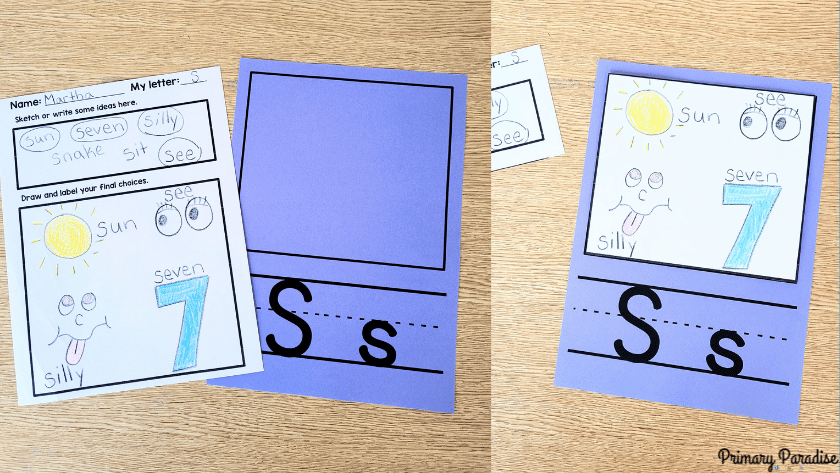
If you’re teaching younger grades, it’s definitely important to have an alphabet with upper and lowercase letters. It’s also helpful if there’s a picture prompt for each letter, but be sure that the picture prompt makes sense. For example, giraffe for g is not a great choice for K-1 students. An alphabet doesn’t have to be fancy, laminated, or expensive. You can find many free options online to print (just look for a student friendly font). You could even hand write your own. However, my favorite option is to have my students create one in the first week of school. (Click here to go to the free resource library to download this template for free.)
Accessible Supplies for Students

I am a firm believer that our job as teachers is to help students be as independent as possible and eventually put ourselves out of the job. So, I recommend having student supplies: scissors, pencils, small white boards, markers, crayons etc. easily accessible for students. You could use table supplies in a small caddy, or you could have them available in a space in your room. You also don’t need to spend money on containers to hold supplies. One of my favorite supply holders are big, plastic yogurt tubs, plastic ice cream containers, or other similar items my family uses often. I just clean them out and they’re a great supply holder. To make them look a bit nicer, I wrap them in construction paper and label them.
A Logically Organized Space
As I mentioned above, our goal should be to develop independent students who can do a lot of things in the classroom on their own. This means we should organize our rooms in a student friendly, logical way. To do this, I recommend thinking through your routines and procedures- how will students come into the classroom in the morning and what will they do? What items will the need access to? How can you make things you will need frequently easily accessible? I can’t answer these questions for your room or your students, but thinking through how your students will move through the space will help you know how to best set things up for them.
And, don’t be afraid to change things up as you notice things not working well. I also recommend thinking through things this way as you’re setting up your supplies and areas. It doesn’t have to look perfect, but it does need to be functional.
A Space to Calm Down
While this isn’t required, I find it super helpful to set up a calm down space in elementary classrooms. Again, it doesn’t have to be fancy or expensive. A designated corner or seat with some crayons and paper, legos or fidgets does the trick. I shared some of my favorite things in this post, but you really can do this with items already in your classroom.
Places to Work
Depending on the size of your room and the age of your students, you might have tables or desks. You could potentially have some flexible seating that comes with your classroom as well. Whether you go a more traditional route with seating, or a more flexible route, your students will need an area to work in. I personally give my students assigned seats, but we change them often and when they’re actually working, they can sit, stand, get a clip board and lay on the carpet, or whatever feels comfortable as long as they are still working. When arranging my tables, I try to maximize my space so there’s room for other areas.
Space for Students to Make Their Mark
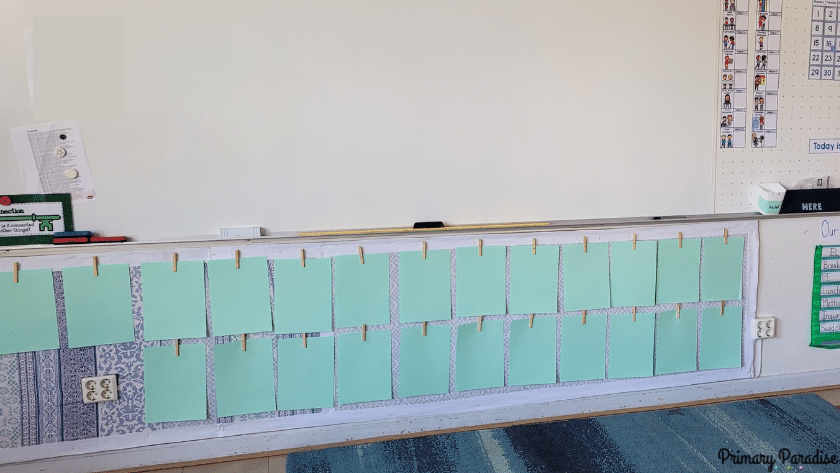
Instead of putting up a bunch of cute, printed posters, consider leaving bulletin boards blank. This allows space to put up the anchor charts you’ll make with students and student work. If you want some fun, motivational quotes, you can even ask your students to make some. However, there’s no need to cover every square inch of the walls. It can be hard, but make sure each item on the walls has a purpose.
A Classroom Library if Possible
While I do believe every classroom should have a classroom library, whether large or small, I also don’t believe that teachers should be responsible for providing it. Unfortunately, many districts don’t. So, if you’re going to spend your money on something, this is a good area to focus on. Even better if you can build a small library for free with the some the tips I mentioned above.
The bottom line is this. You can set up a classroom that is a great space to learn without spending a lot of money.
Still feeling overwhelmed? Grab this classroom set up checklist for free.
Click to download this 3 page classroom set up checklist in my free resource library for newsletter subscribers.
Keep reading and learning:
- How to Plan a Successful Morning Routine
- How to Set Up Classroom Jobs
- A Comprehensive List of Things Students can do Independently
- What I do Instead of Guided Reading
